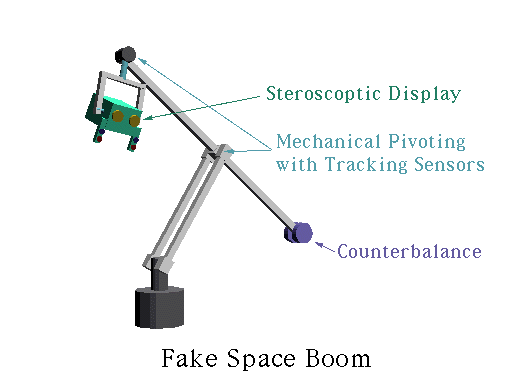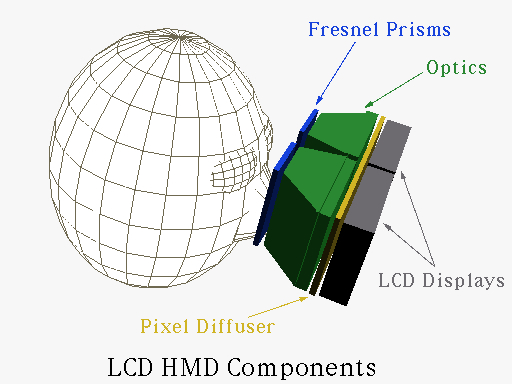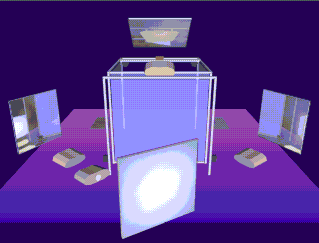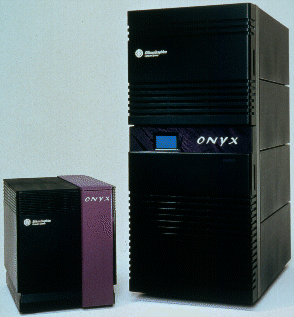Binaural audio
- The literal interpretation is "stereo" but in the context
it means that the audio is spatially pinpointable in 3 dimensions
It was discovered how to modify sounds by trial and error: by placing
microphones in people's ears and determining exactly how the source
sound was modified from the original depending on the source sound's
position around the head of the subject.
Systems
- Convolvotron
- This is a desktop sized unit which costs around $25,000. The
state of the art for some years.
- DSP Based systems
- Recently the development of DSP technology has reduced the cost
of such systems to about $10 and has reduced the size enough to make
them embeddable.
Special Effects
- Reverberation, Echo and Realism
- Special effects must be computed relative to the VR user's apparent
position. This is very difficult, comparable to doing radiosity in the
visual world.
Tactile
- Feedback to user
- Also known as "Haptics"
Vibrating Joystick
- Simulates "Crash and burn"
Digression: Much of the pre-commercial VR technology
was developed by the military. Of particular interest was military
aircraft simulation which not only protected the (somewhat expendable)
inexperienced pilot, but (primarily) the U.S. military's multi-million
dollar investment.
Wand solenoids and Motors
Glove Bladders
- Provides feedback with pneumatic bladders that inflate inside the glove
when simulated contact is made in the virtual world. Generally too
slow to be effective.
Exoskeletons
- Force feedback
- When modeling molecules in VR, an exoskeleton can simulate
repulsion and attraction.
- Prevents movement.
- Normally in a virtual world, there is nothing
physically to stop you from moving through walls--unless
there is an exoskeleton with sufficiently powerful motors
to control movement.
Largely an unsolved problem
Transducers/Tracking
- Provides feedback to the machine
There are two basic movement paradigms:
Walking-Like
- Movement´VR-Response
- Provides a one-to-one "real-world" movement and the
corresponding virtual world movement.
- In some circumstances, this can be rather tiring and/or
slow. It can also severely limit the travel distance
without more hardware such as treadmills used in
some architectural walk-throughs.
Vehicle-Like
- Constant motion
- The user only indicates motion and speed changes. Usually
found in aircraft or land vehicle simulators, or games where
"flying" is required.
Wands, HMDs
The idea here is to provide as many degrees of freedom as possible for
realistic motion response. The ultimate is 6 DOF: Yaw, Pitch, Roll in
addition to the X, Y, and Z coordinates in 3-space.
Technologies
- Magnetic
- Three magnetic field generators are placed in proximity to a sensor
located on the wand. The generators fire sequentially and a computer
triangulates, based on the magnetic strength, where the sensor is in 3-space.
- Ultrasonic
- This works much like the magnetic sensors, only using sound. Instead of "strength" these sensors measure the time it takes for the sound to get from the generator to the sensor.
- Exoskeleton
- Sensors at each joint or rotation axis are able to keep track
of user movement very accurately. The trade-off is that this technology
is quite cumbersome.
- Intertial
- On HMDs, intertial sensors are oft-used for keeping track of head
rotation. Unfortunately, these types of sensors are particularly
unreliable for precise measurement such as that required for VR work.
They are more frequently used to keep track of how far a missile has
traveled.
- Optical
- Sensors in the Wand or HMD "count" light emmissions from the
environment to determine position.
- Robot Vision
- Sufficiently sophisticated HMD-mounted pattern matching that is
able to determine position and orientation by taking visual cues from the
outside scenery.
- This is not currently feasible (although highly desirable).
Gloves
- Detect finger flexion
- Fiber optics
- Glass filaments located in the fingers of the glove
that have been appropriately "slashed" leak
light in proportion to the amount that the fiber has been
flexed. This is detected by optoelectronics in the glove
and digitized.
- Exoskeleton
- Chordgloves--Pinch Sensors
- Determines how much pressure one is using to
grab a virtual object. It imparts the potential to "crush" or deform
object's shape.
Processing
You can never get enough processing power.
Simulation
The basic goal is to sufficiently simulate reality. Of course, this
depends on how demanding one's definition of VR is. If "Doom" is
sufficient, then you will need significantly less power.
Rendering
- Raytrace
- Models objects
- Point light sources
- View dependent
- Rays of light from the eye propagate through objects.
- Radiosity
- Models light
- Diffuse, area lighting; realistic shadows.
- View independent (conditionally)
- Surface patches ("emitters") bounce light from one to the other.
SGI
If attempting to do any kind of heavy-duty VR, life begins and ends at 
SGML....HTML...VRML!
Goals
- Platform Independent
- Consistency
- Integrate with the WWW
- Large shared space
- Interactive
Defines
- Objects
- These are the actual "things" available in the VRML space.
- Scenes
- Where the objects are, relative to one another.
- Binding mechanism
- Matches the 3D space to VRML servers on the network.
Instead of providing the VRML browser with network addresses, one
simply gives it a set of three dimensional coordinates. Servers which
potentially have objects in this space return return them.
No pictures yet! It is largely theoretical, however the claim is that
a browser is currently being developed: Labyrinth
Code Snippet:
Cube {
width 2 # SFFloat
height 2 # SFFloat
depth 2 # SFFloat
}
Wired's VRML page
Problems




